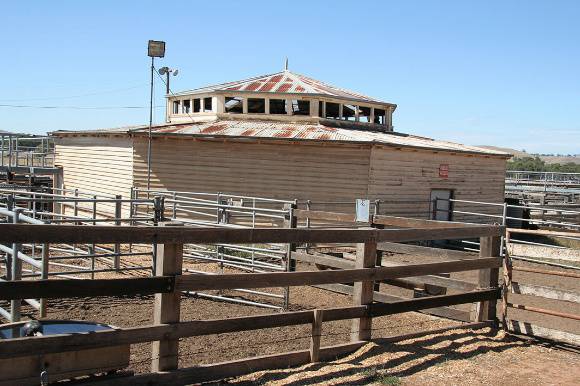| Back to search results » | Back to search page » |
|
STOCK SELLING RING
Other NamesSALEYARDS , SALE YARDS Location19 SPRING STREET CASTERTON, GLENELG SHIRE
File NumberPL-HE/03/1143LevelRegistered |
|
Statement of Significance
What is significant? The Casterton Stock Selling Ring building is located in the municipal cattle sale yards across the Wannon River to the south of the Casterton town centre. The plan of the stock selling ring building is based on an octagon within an octagon. The inner ring, for presentation of stock, is surrounded by timber planking and steel tube barriers, and is covered by an octagonal lantern roof on heavy hardwood posts. Tiered timber seating surrounds the ring on five sides, broken by a central pedestrian entrance way approached from outside the yards to the east. The seating area is enclosed with weatherboard stud-framed walls and corrugated iron roofing. On the other three sides the ring is open, with the central bay occupied by a weatherboard auctioneers box and the openings on either side having gates for stock from the yards beyond. The open sides on an octagonal stock selling ring building are unusual, and give a strong connection to the yards surrounding it. The Casterton stock selling ring dates from the mid 1920s when the new municipal sale yards were opened. Prior to this there were private stock selling yards at a number of points around the town, and cattle were droved through the main street. With public demand for demand for better, larger, publicly owned yards away from the town centre, the Shire Council started planning municipal yards from 1913. Plans for the current site begun in 1918. The yards were opened in 1925, with further construction occurring in 1926. The Stock Selling Ring building was probably designed by the long serving Shire Engineer, Claude Alexander Mickle and built by the local contractors, John and Ernest Spurrell, who won the tender for the yards. The ring was mainly used for selling bulls or pedigree cows and, sometimes, for selling horses. It is now used for breaking out stock, and the seating is used for eating lunch. The two big weaner store sales held by stock agents in January are the major annual events at the Casterton yards. Cattle from this area are recognised as being of high quality, and the ongoing use of these yards is considered an important factor in maintaining this regional identity. How is it significant? The Casterton Stock Selling Ring is of architectural and historical significance to the State of Victoria. Why is it significant? The Casterton Stock Selling Ring is of architectural significance as one of the few remaining examples of the specialized building type of the stock selling ring, which was once common in the State. The Casterton Stock Selling Ring is of architectural significance within the variations of that building type, as an example of the use of an octagonal building form for an enclosed ring. The Casterton building is also unusual as an octagonal selling ring with partly open sides, where other remaining octagonal examples in the State are fully enclosed. The Casterton Stock Selling Ring is of historical significance for its association with the development of the pastoral industry in Victoria following selection and Soldier Settlement, and in particular with the development of activities and facilities associated with the sale and distribution of livestock. The Casterton Stock Selling Ring is of historical significance for its association with the increasing involvement of rural local governments in building and running stockyards from the beginning of the twentieth century. The Casterton Stock Selling Ring is of historical significance for its association with the sale of livestock in the further Western District, reflecting the increasing market of the selection and closer settlement periods and the post-War prosperity of the 1920s. The selling ring and the cattle yards demonstrate the importance of Casterton as a source of quality breeding stock for the pastoral industry.
Group
Farming and Grazing
Category
Yarding/ Loading Facility












